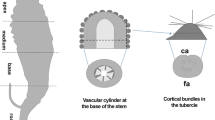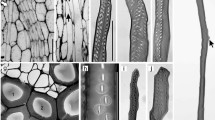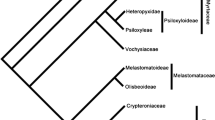Abstract
Wide-band tracheids are a specialized tracheid type in which an annular or helical secondary wall projects deeply into the cell lumen. They are short, wide and spindle-shaped, and their bandlike secondary walls cover little of the primary wall, leaving most of it available for water diffusion. Wide-band tracheids appear to store and conduct water while preventing the spread of embolisms. They may be the most abundant tracheary element in the xylem, but they are always accompanied by at least a few vessels. Typically, fibers are absent wherever wide-band tracheids are present. Wide-band tracheids occur in the primary and secondary xylem of succulent stems, leaves and roots in genera of all three subfamilies of Cactaceae but were not found in the relictual genusPereskia, which lacks succulent tissues. In the large subfamily Cactoideae, wide-band tracheids occur only in derived members, and wide-band tracheids of North American Cactoideae are narrower and are aligned in a more orderly radial pattern than those of South American Cactoideae. Wide-band tracheids probably arose at least three times in Cactaceae.
Similar content being viewed by others
References
Bailey, I.W. 1960. Comparative anatomy of the leaf-bearing Cactaceae, I. Foliar vasculature ofPereskia, Pereskiopsis, andQuiabentia. J. Arnold Arbor.41: 341–356.
Bailey, I.W. 1964. Comparative anatomy of the leaf-bearing Cactaceae, XI. The xylem ofPereskiopsis andQuiabentia. J. Arnold Arbor.45: 140–157.
Bailey, I.W. andSrivastava, L.M. 1962. Comparative anatomy of the leaf-bearing Cactaceae, IV. The fusiform initials of the cambium and the form and structure of their derivatives. J. Arnold Arbor.43: 187–202.
Barthlott, W. andHunt, D.R. 1993. Cactaceae.In K. Kubitzki, ed., The Families and Genera of Vascular Plants, Springer-Verlag, Berlin, pp. 161–197.
Boke, N.H. 1944. Histogenesis of the leaf and areole inOpuntia cylindrica. Amer. J. Bot.31: 299–316.
Britton, N.L. andRose, J.N. 1920. The Cactaceae. Carnegie Institution of Washington, Washington, D.C.
Carlquist, S. 1975. Ecological Strategies of Xylem Evolution. University of California Press, Berkeley.
Carlquist, S. 1980. Further concepts in ecological wood anatomy, with comments on recent work in wood anatomy and evolution. Aliso9: 499–553.
Carlquist, S. 1988. Comparative Wood Anatomy. Systematic, Ecological and Evolutionary Aspects of Dicotyledon Wood. Springer-Verlag, Berlin.
Conde, L.F. 1975. Anatomical comparisons of five species ofOpuntia (Cactaceae). Ann. Missouri Bot. Gard.62: 425–473.
Gibson, A.C. 1973. Comparative anatomy of secondary xylem in Cactoideae (Cactaceae). Biotropica5: 29–65.
Gibson, A.C. 1977a. Wood anatomy of opuntias with cylindrical to globular stems. Bot. Gaz.138: 334–351.
Gibson, A.C. 1977b. Vegetative anatomy ofMaihuenia (Cactaceae) with some theoretical discussions of ontogenetic changes in xylem cell types. Bull. Torrey Bot. Club104: 35–48.
Gibson, A.C. 1978a. Woody anatomy of platyopuntias. Aliso9: 279–307.
Gibson, A.C. 1978b. Structure ofPterocactus tuberosus, a cactus geophyte. Cact. Succ. J. (U.S.)50: 41–43.
Hunt, D.R. 1967. Cactaceae.In J. Hutchinson, ed., The Genera of Flowering Plants, vol. 2, Clarendon Press, Oxford, pp. 427–467.
Hunt, D. andTaylor, N. 1990. The genera of Cactaceae: progress towards consensus. Bradleya8: 85–107.
Mauseth, J.D. 1989. Comparative structure-function studies within a strongly dimorphic plant,Melocactus intortus (Cactaceae). Bradleya7: 1–12.
Mauseth, J.D. 1993a. Water-storing and cavitation-preventing adaptations in wood of cacti. Ann. Bot.72: 81–89.
Mauseth, J.D. 1993b. Medullary bundles and the evolution of cacti. Amer. J. Bot.80: 928–932.
Mauseth, J.D. 1995. Collapsible water-storage cells in cacti. Bull. Torrey Bot. Club122: 145–151.
Mauseth, J.D. Comparative anatomy of Tribes Cereeae and Browningieae (Cactaceae). Bradleya. (in press)
Mauseth, J.D. andFujii, T. 1994. Resin-casting: a method for investigating apoplastic spaces. Amer. J. Bot.81: 104–110.
Mauseth, J.D., Montenegro, G. andWalckowiak, A.M. 1984. Studies of the holoparasiteTristerix aphyllus (Loranthaceae) infectingTrichocereus chilensis (Cactaceae). Can. J. Bot.62: 847–857.
Mauseth, J.D. andPlemons, B.J. 1995. Developmentally variable, polymorphic woods in cacti. Amer. J. Bot.82: 1199–1205.
Mauseth, J.D. andRoss, R.G. 1988. Systematic anatomy of the primitive cereoid cactusLeptocereus quadricostatus. Bradleya6: 49–64.
Mauseth, J.D. andSajeva, M. 1992. Cortical bundles in the persistent, photosynthetic stems of cacti. Ann. Bot.70: 317–324.
Robinson, H. 1974. Scanning electron microscope studies of the spines and glochids of the Opuntioideae (Cactaceae). Amer. J. Bot.61: 278–283.
Sajeva, M. andMauseth, J.D. 1991. Leaf-like structure in the photosynthetic, succulent stems of cacti. Ann. Bot.68: 405–411.
Sattler, R. 1988. Homeosis in plants. Amer. J. Bot.75: 1601–1617.
Schleiden, M.J. 1845. Beiträge zur Anatomie der Cacteen. Mém. Acad. Imp. Sci. St.-Pétersbourg4: 335–380.
Tyree, M.T. andSperry, J.S. 1989. Vulnerability of xylem to cavitation and embolism. Annu. Rev. Pl. Physiol. Pl. Mol. Biol.40: 19–38.
Zimmermann, M.H. 1983. Xylem Structure and the Ascent of Sap. Springer-Verlag, Berlin.
Author information
Authors and Affiliations
Rights and permissions
About this article
Cite this article
Mauseth, J.D., Uozumi, Y., Plemons, B.J. et al. Structural and systematic study of an unusual tracheid type in cacti. J. Plant Res. 108, 517–526 (1995). https://doi.org/10.1007/BF02344242
Received:
Accepted:
Issue Date:
DOI: https://doi.org/10.1007/BF02344242




